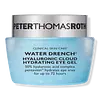What's inside
What's inside
 Key Ingredients
Key Ingredients

 Benefits
Benefits

 Concerns
Concerns

 Ingredients Side-by-side
Ingredients Side-by-side

Water
Skin ConditioningGlycerin
HumectantDipropylene Glycol
HumectantPolyacrylic Acid
Emulsion StabilisingAgar
MaskingNiacinamide
SmoothingSodium Polyacrylate
AbsorbentTranexamic Acid
AstringentKojic Acid
AntioxidantArbutin
AntioxidantAlpha-Arbutin
AntioxidantCaffeine
Skin ConditioningDipotassium Glycyrrhizate
HumectantGlutathione
Adenosine
Skin ConditioningHydroxyacetophenone
AntioxidantCaprylyl Glycol
EmollientCellulose Gum
Emulsion StabilisingXanthan Gum
EmulsifyingDisodium EDTA
Tartaric Acid
BufferingAluminum Glycinate
AstringentCetyl Ethylhexanoate
EmollientCaprylyl/Capryl Glucoside
CleansingWater, Glycerin, Dipropylene Glycol, Polyacrylic Acid, Agar, Niacinamide, Sodium Polyacrylate, Tranexamic Acid, Kojic Acid, Arbutin, Alpha-Arbutin, Caffeine, Dipotassium Glycyrrhizate, Glutathione, Adenosine, Hydroxyacetophenone, Caprylyl Glycol, Cellulose Gum, Xanthan Gum, Disodium EDTA, Tartaric Acid, Aluminum Glycinate, Cetyl Ethylhexanoate, Caprylyl/Capryl Glucoside
Water
Skin ConditioningButylene Glycol
HumectantDimethicone
EmollientGlycerin
HumectantPolysilicone-11
Sodium Hyaluronate
HumectantLens Esculenta Fruit Extract
Skin ConditioningPyrus Malus Fruit Extract
Skin ConditioningCaffeine
Skin ConditioningTocopheryl Acetate
AntioxidantMalachite Extract
AntioxidantHydrolyzed Silk
HumectantOryza Sativa Bran Extract
Skin ConditioningCeramide NP
Skin ConditioningPalmitoyl Oligopeptide
CleansingPalmitoyl Tetrapeptide-7
Skin ConditioningBiotin
AntiseborrhoeicCeramide EOP
Skin ConditioningSilybum Marianum Seed Extract
Skin ConditioningBetula Alba Bark Extract
MaskingChrysin
Skin ConditioningCitrullus Lanatus Fruit Extract
Skin ConditioningCeramide AP
Skin ConditioningAscorbyl Palmitate
AntioxidantCeramide Ns
Skin ConditioningPhenoxyethanol
PreservativePEG-240/Hdi Copolymer Bis-Decyltetradeceth-20 Ether
StabilisingCeramide As
Skin ConditioningSaccharide Isomerate
HumectantAcrylamide/Sodium Acryloyldimethyltaurate Copolymer
Emulsion StabilisingIsohexadecane
EmollientHydroxyethylcellulose
Emulsion StabilisingDimethylacrylamide/Acrylic Acid/Polystyrene Ethyl Methacrylate Copolymer
Skin ConditioningCholesterol
EmollientSodium Acryloyldimethyltaurate/Vp Crosspolymer
Emulsion StabilisingPolysorbate 80
EmulsifyingSodium Lactate
BufferingSodium Benzoate
MaskingDecyl Glucoside
CleansingPotassium Sorbate
PreservativeSorbitan Oleate
EmulsifyingEthylhexylglycerin
Skin ConditioningSodium PCA
HumectantCaprylyl Glycol
EmollientHexylene Glycol
EmulsifyingCeteareth-25
CleansingCitric Acid
BufferingSodium Citrate
BufferingT-Butyl Alcohol
PerfumingSteareth-20
CleansingHydrogenated Lecithin
EmulsifyingCetyl Alcohol
EmollientChlorhexidine Digluconate
AntimicrobialDipropylene Glycol
HumectantDisodium EDTA
Tocopherol
AntioxidantPotassium Laurate
EmulsifyingDisodium Phosphate
BufferingPolysorbate 60
EmulsifyingBehenyl Alcohol
EmollientGlyceryl Stearate
EmollientSucrose Distearate
EmollientN-Hydroxysuccinimide
Skin ConditioningSodium Phosphate
BufferingWater, Butylene Glycol, Dimethicone, Glycerin, Polysilicone-11, Sodium Hyaluronate, Lens Esculenta Fruit Extract, Pyrus Malus Fruit Extract, Caffeine, Tocopheryl Acetate, Malachite Extract, Hydrolyzed Silk, Oryza Sativa Bran Extract, Ceramide NP, Palmitoyl Oligopeptide, Palmitoyl Tetrapeptide-7, Biotin, Ceramide EOP, Silybum Marianum Seed Extract, Betula Alba Bark Extract, Chrysin, Citrullus Lanatus Fruit Extract, Ceramide AP, Ascorbyl Palmitate, Ceramide Ns, Phenoxyethanol, PEG-240/Hdi Copolymer Bis-Decyltetradeceth-20 Ether, Ceramide As, Saccharide Isomerate, Acrylamide/Sodium Acryloyldimethyltaurate Copolymer, Isohexadecane, Hydroxyethylcellulose, Dimethylacrylamide/Acrylic Acid/Polystyrene Ethyl Methacrylate Copolymer, Cholesterol, Sodium Acryloyldimethyltaurate/Vp Crosspolymer, Polysorbate 80, Sodium Lactate, Sodium Benzoate, Decyl Glucoside, Potassium Sorbate, Sorbitan Oleate, Ethylhexylglycerin, Sodium PCA, Caprylyl Glycol, Hexylene Glycol, Ceteareth-25, Citric Acid, Sodium Citrate, T-Butyl Alcohol, Steareth-20, Hydrogenated Lecithin, Cetyl Alcohol, Chlorhexidine Digluconate, Dipropylene Glycol, Disodium EDTA, Tocopherol, Potassium Laurate, Disodium Phosphate, Polysorbate 60, Behenyl Alcohol, Glyceryl Stearate, Sucrose Distearate, N-Hydroxysuccinimide, Sodium Phosphate
 Reviews
Reviews

Ingredients Explained
These ingredients are found in both products.
Ingredients higher up in an ingredient list are typically present in a larger amount.
Caffeine is most associated with coffee, tea, and cacao. In skincare, it helps with calming inflammation and is rich in antioxidants.
While caffeine is used to treat cellulite and and dark circles, further studies are needed to prove this. It has been believed to help with these skin conditions due to its ability to dilate blood vessels and increase blood flow.
Some studies are looking into caffeine's ability to protect against UV rays.
Learn more about CaffeineCaprylyl Glycol is a humectant and emollient, meaning it attracts and preserves moisture.
It is a common ingredient in many products, especially those designed to hydrate skin. The primary benefits are retaining moisture, skin softening, and promoting a healthy skin barrier.
Though Caprylyl Glycol is an alcohol derived from fatty acids, it is not the kind that can dry out skin.
This ingredient is also used as a preservative to extend the life of products. It has slight antimicrobial properties.
Learn more about Caprylyl GlycolDipropylene Glycol is a synthetically created humectant, stabilizer, and solvent.
This ingredient helps:
Dipropylene glycol is technically an alcohol, but it belongs to the glycol family (often considered part of the ‘good’ alcohols). This means it is hydrating and gentle on skin unlike drying solvent alcohols like denatured alcohol.
As a masking agent, Dipropylene Glycol can be used to cover the smell of other ingredients. However, it does not have a scent.
Studies show Dipropylene Glycol is considered safe to use in skincare.
Learn more about Dipropylene GlycolDisodium EDTA plays a role in making products more stable by aiding other preservatives.
It is a chelating agent, meaning it neutralizes metal ions that may be found in a product.
Disodium EDTA is a salt of edetic acid and is found to be safe in cosmetic ingredients.
Learn more about Disodium EDTAGlycerin is already naturally found in your skin. It helps moisturize and protect your skin.
A study from 2016 found glycerin to be more effective as a humectant than AHAs and hyaluronic acid.
As a humectant, it helps the skin stay hydrated by pulling moisture to your skin. The low molecular weight of glycerin allows it to pull moisture into the deeper layers of your skin.
Hydrated skin improves your skin barrier; Your skin barrier helps protect against irritants and bacteria.
Glycerin has also been found to have antimicrobial and antiviral properties. Due to these properties, glycerin is often used in wound and burn treatments.
In cosmetics, glycerin is usually derived from plants such as soybean or palm. However, it can also be sourced from animals, such as tallow or animal fat.
This ingredient is organic, colorless, odorless, and non-toxic.
Glycerin is the name for this ingredient in American English. British English uses Glycerol/Glycerine.
Learn more about GlycerinWater. It's the most common cosmetic ingredient of all. You'll usually see it at the top of ingredient lists, meaning that it makes up the largest part of the product.
So why is it so popular? Water most often acts as a solvent - this means that it helps dissolve other ingredients into the formulation.
You'll also recognize water as that liquid we all need to stay alive. If you see this, drink a glass of water. Stay hydrated!
Learn more about Water